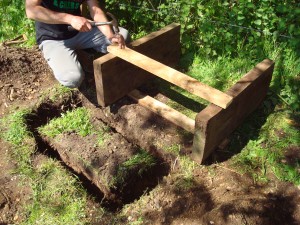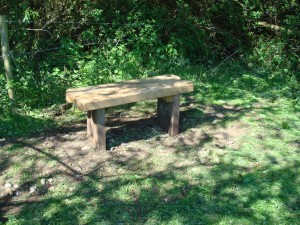Our task of the day was located at the Marston Marsh Reserve, to the south of City Centre. In order to get onto the reserve, Tom had to drive our van on a bumpy dirt path. Once we got on to the marsh, we split into two groups. The task of the first group was to remove rotting fence posts from the periphery of the marshland. During the summer, the marsh hosts several cows that keep the level of the grass down to a manageable level. Because these cows are graciously loaned by surrounding farm owners, the groundskeeper of the marsh needed to ensure that they would not escape the marsh and become sad, lost cows. I volunteered for the second group. Our task was to install a bench for the park goers. We decided to place the bench facing a small stream that runs through the marsh. First, we had to remove several branches from the area in order to make the bench accessible. Then we determined where the columns of the bench would be placed, and began digging.
Using a spade, I began digging a hole approximately one and a half feet deep. The layer of topsoil was easily removed and discarded to the side. However, the bedrock below the marsh soon proved to be extremely difficult to dig through. My accomplices used a spear shaped iron tool as leverage to separate the bedrock, which was heavily compressed into the soil. Then, I would use the spade to break up and separate the bedrock from the soil further. The rocks were difficult to remove using the spade, so I often had to remove and discard them by hand. I repeated this process several times, occasionally causing sparks from the spade hitting the bedrock. Des joked that I was lucky that there wasn’t much gas under the marsh.
Luckily, the bedrock gave way to softer clay, and we were able to insert the columns of the bench into the ground. Then, we dug two ditches that were perpendicular to the columns that had been placed into the ground. These were much more shallow than the depth that the columns needed, but we needed enough depth on the side of the columns so that side bars could be placed on the front and back of the bench. These sidebars would be buried underneath the ground, in order to make the bench too difficult to remove for any of the vandals that frequent the marsh.
After nailing the sidebars into the column, we placed the base of the bench back into the ditch. A support block was placed on the inside of each column, and each block was held to the column by a large gauge bolt. Using a twist drill bit, we drilled a hole for the bolt through the side of the column and the support block. Two holes were drilled on each side of the column and block, and were attached using the bolts. Then, we attached the seat of the bench to the support blocks. The seat comprised of two oak boards, which were secured onto the support blocks by first using a drill bit to make a hole, and then securing the oak boards to each support block using a large gauge bolt. After all of the bolts were secured using a washer plate and two nuts, I used a hammer to beat down the threads of each bolt, thereby preventing any thieves from removing the nuts and deconstructing the bench. Because the bench was constructed using only oak, and bolted instead of using nails, we were confident that any thieves attempting theft of the bench would give up out of frustration.
My palms were fairly bruised and sore from using the spade to break the bedrock, but I was satisfied that park goers would enjoy our creation for years to come. I learned that a well-maintained fence must supervise cows, for fear that they escape. I also discovered that the landscape of a marsh may look soft and lush, but the ground beneath may be tough to break through. But the most valuable lesson of the day was learning how to theft-proof a bench in a public park.
Date: 3/5/11
Time: 930 to 1330
Hours: 6 / Total: 18
Supervisor: Debbie Murray



0 responses so far ↓
There are no comments yet...Kick things off by filling out the form below..
You must log in to post a comment.